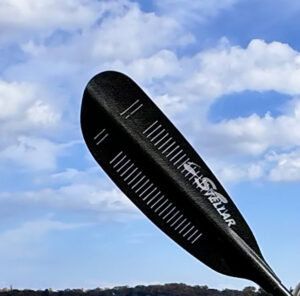Being an avid paddler requires more than just dedication to the sport; it requires reliable equipment and tools to perform well. It took years of paddling before I found what worked best for me, given the way I approach kayaking, canoeing and expeditions.
I’m currently five months into attempting the ‘Great Loop’, which is the North American cruise route circumnavigating the eastern United States through parts of Canada, The East Coast, Gulf of Mexico, Mississippi River and Great Lakes. The loop is 9,656km long and typically ends in the same location you start in. My objective is to do this cruise route in the wrong boat (canoe), and the wrong direction (clockwise), meaning I’d eventually have to paddle up the Mississippi, against the current.
Having a Stellar Slit Blade in my grasp was like carrying a sword compared to a butter knife. I could quite literally feel the power and potential in the palm of my hands. I remember vividly, because it was a revolutionary part of my current expedition; the crossing of Lake Ontario, from the mainland of Canada to Oswego, New York. The paddle features thin slits through the blade, a design by Oscar Propulsions that promises better performance for the user, and a reduction of fatigue experienced while using due to the paddles ability to displace water pressure through the slits, effectively resulting in a smoother stroke without sacrificing any power from your stroke.
This was my first real opportunity to put my new arsenal to the test, where I had a small weather window to cross one of the largest bodies of fresh water in the world. This segment, from the mainland of Canada to Oswego spanned 71 miles over four days, with nights off to sleep in my tent on islands throughout the crossing.
I must say I was pleasantly surprised with the quality and efficiency the slit blade provided me, as opposed to my usual standard carbon fiber, I found the use of this tool to increase my performance by nearly 1.5mph on average. Over the four days of actual paddling, I spent 18 hours in the canoe (not including rests), pushing a near 450lb mass object (canoe, equipment, plus me), for 71 miles. Mind you, these are touring numbers, not racing ones. I’m only trying to get from point A to point B as efficiently as possible without the cost of my strength. Being sore the next day unable to paddle isn’t efficient, so for a pace this consistent while touring, left me quite pleased.
My daily averages until this point with a standard non-slit double blade worked out to 3mph to 3.4mph through a standard day on the water (8+ hours). My crossing, only factoring weather, set my daily average to nearly 4mph on open water in advanced Great Lake conditions. As a long distance athlete, these numbers were impressive, but I still needed convincing. I ran a similar test a week later on the crossing of Lake Oneida; a 20 mile long lake that runs west to east in upstate New York. I succeeded in my crossing using the Stellar Slit Blade in 4 hours and 30 minutes of continuous paddling, fully loaded, setting an average of 4.4mph, an astounding pace for touring on flat water.

With the reduction of fatigue that I experienced while using their technology, I found the paddles had the remarkable ability to almost completely eliminate my lower back pain that I’d experience while paddling. In a long history of events, I’ve gone through a spinal surgery as a teenager, resulting in a chronic lower back pain. One of the many ways these paddles had piqued my interest, was their effectiveness in helping me perform better on the water, due to their fatigue reducing attributes. After the first few days of using it, my back pain while paddling was practically nonexistent, and just that quality alone I think will make this technology the cornerstone for the paddling world.
Follow Peter @captainpeterfrank
